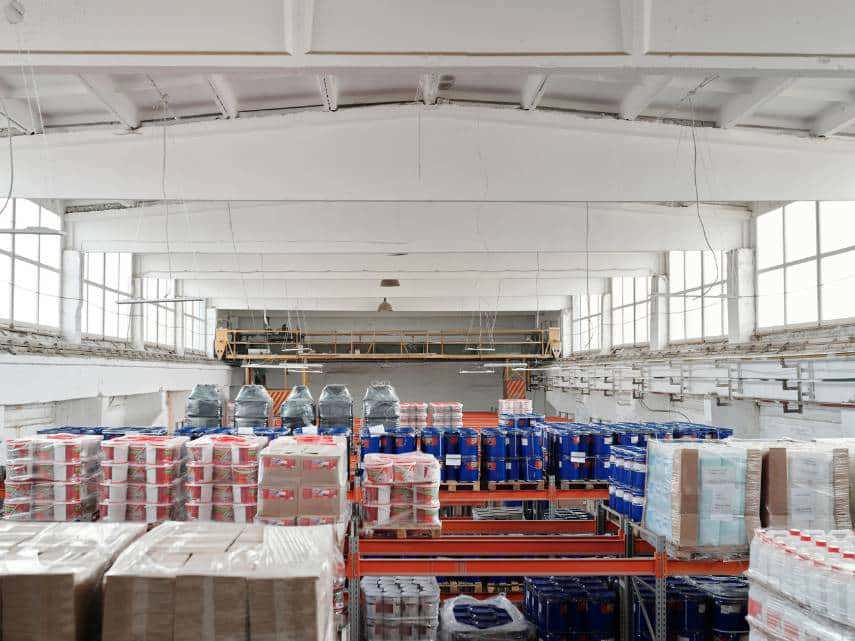
Inventory replenishment is reordering stock in the right quantities, at the right time. Too much inventory can increase costs, limit cash flow, and leave you with expired stock. Too little, and you risk disappointing customers with slow fulfilment times.
An optimised inventory replenishment strategy ensures items are reordered from suppliers in time to meet demand, while preventing overstocking of products, raw materials, and parts.
What is inventory replenishment?
Inventory replenishment is the process of purchasing the goods, components, and raw materials needed to build and sell products. It ensures products and materials are procured and delivered to the warehouse in a cost-effective, timely way.
The replenishment process involves sourcing suppliers, procuring products and materials, developing effective delivery processes and coordinated lead times, and regularly reviewing current inventory processes.
Stock replenishment is a key part of inventory management and should work in accordance with an overarching inventory management strategy.
Why inventory replenishment is so important
Poorly managed inventory replenishment can negatively impact your customers and the overall health of your business. The problems it causes result in lost revenue, reduced profits, and damaged reputation. Inventory replenishment helps makers and sellers avoid serious issues like stockouts, delayed shipments, and overstocking.
 Inventory replenishment helps maintain optimum levels of stock and avoid delayed customer orders.
Inventory replenishment helps maintain optimum levels of stock and avoid delayed customer orders.
When handled correctly, inventory replenishment benefits a business by:
- Freeing up cashflow through minimal stocking. Inventory replenishment involves negotiating bulk-buying discounts and considering seasonal changes to cost. Done right, this minimises cost and releases cashflow for other areas of your business.
- Preventing stock expiry. Stock expiry and wastage are costly, but they can be avoided. Coordinating the purchase and delivery of new stock so that it never arrives too late or too early is essential to negating stock expiry (and delays in shipping to the customer).
- Reducing overall freight costs. Procuring suppliers that are closer to your facilities, or charge less for freight, is a key part of the inventory replenishment process. It may be possible to avoid air freight costs if the product can be ordered with enough lead time to allow for truck, ship, or train delivery. Bulk buying can also provide leverage for discounted delivery costs.
We recommend appointing a specific person to the role of Inventory Replenishment Manager to ensure your business has access to these important benefits by ticking every box.
Inventory replenishment methods and strategies
“[Organisation] is key to infrastructural continuity. Disorganisation can cause stock to get backed up or even lost, which hinders the replenishing process of the shelves and also puts additional stress on employees.”
- Francis Matthew Auriemma, President at Far-Aum Quest, Business Consulting Enterprises, via Lightspeed
Stock replenishment should follow a set process, or workflow, that ensures products and materials are regularly reordered at the optimal time for your business.
Even with a low amount of stock to replenish there are still risks that could turn everything awry if left unmanaged.
These include challenges such as:
- Unreliable forecasting
- Sales deviating from forecasted numbers
- Insufficient storage space
- Third-party delays
- Unpredictable lead-times
To ensure you’re prepared for the worst, you need a replenishment strategy in place.
Common inventory replenishment methods
The first step in managing your replenishment is to decide which of the following reordering methods are best suited to your stock.
There are three common methods for approaching inventory replenishment: The Pull method, the Push method, and a hybrid solution.
Let’s break these down.
The pull method of inventory replenishment
The ‘Pull’ method, sometimes called the ‘Just-in-Time’ method, is a lean-manufacturing strategy that involves producing goods only when they’re needed – in other words, production begins as soon as an order is placed.
This method responds to customer demands, keeping inventory costs low and preventing overproduction. It’s best suited to products that have limited demand, or where the cost of managing excess exceeds the benefit of carrying extra stock.
The push method of inventory replenishment
The ‘Push’ method, sometimes called the ‘Just-in-Case’ method, is an inventory management strategy that forecasts demand and aims to produce goods ahead of time – before an order has been placed.
This method involves carrying large amounts of inventory as stock so that it’s ready to ship out as soon as the customer requests it. It’s ideal for businesses with long lead times or products that are in high demand.
A hybrid replenishment approach
Most businesses are not black and white, so a hybrid method (or a ‘push-pull strategy’) is needed. The hybrid approach is recommended for products with high uncertainty around demand.
One example of the push-pull method in action is when a manufacturer orders the materials required for an assembly prior to the end product being ordered (pull method) but does not begin an assembly until an order has been placed (push method).
Ultimately, the method that’s best for your business will be determined by your products and the priority of your various business functions.
 A hybrid stock replenishment method offers flexibility around reordering parts or products.
A hybrid stock replenishment method offers flexibility around reordering parts or products.
Choosing the right inventory replenishment strategy
Once you’ve determined the best method for reordering stock, you need to systemise that method with a replenishment strategy.
Most businesses use one of the following stock replenishment strategies:
- Periodic inventory replenishment. This is a low-cost, easy-to-implement strategy that’s ideal for small businesses with limited inventory. Manually measure your inventory and the cost of goods sold (COGS) at set intervals (bi-weekly, monthly, quarterly) to determine which stock requires replenishment. This strategy works best with a ‘push’ or hybrid approach to reordering.
- Reorder point (also known as min/max) replenishment. In this strategy, replenishment is automated based on minimum and maximum stock levels. The minimum stock level, once reached, will trigger an automatic order of more stock. The maximum stock level will help to prevent overstock and determine how much stock gets ordered each time. This strategy works best with ‘push’ or hybrid reorder methods.
“Ensure that every product’s minimum stock is accurately set. Do your claims and write-offs daily to ensure that your suggested orders are accurate. Adjust minimum stock for seasonality.”
- John Kotze, Retailer at Pick n Pay, via Lightspeed
- Top-off (also known as lean-time) replenishment. This is a strategy that requires minimal storage and minimises excess stock. Inventory levels are topped off during downtime or slow periods of selling. Top-off replenishment is ideal for inventory that relies on a ‘pull’ approach for reordering.
- Demand replenishment. In demand replenishment, you use demand forecasting to identify the SKUs and quantities of stock that will need to be reordered ahead of time. This strategy allows for better supply chain planning, proactive replenishment, and maximised sales revenue. It’s a perfect fit for a ‘push’ reordering method but can be applied to a hybrid approach as well.
Your inventory replenishment strategy should not be set in stone. Always be looking to adjust or completely pivot your strategy if new business goals demand you do so.
When you’ve determined which method(s) and strategy are best for your business, you must optimise them to ensure your processes function as efficiently as possible.
How to optimise your inventory replenishment strategy
Inventory replenishment is more than just reordering goods to use in assemblies or as stock.
To best benefit your business, you must procure and manage suppliers that are a great fit for your business.
This means:
- Researching and comparing various suppliers.
- Negotiating supplier contracts that are most beneficial to your business and clearly outline the process for mitigating problems that may arise.
- Implementing the most effective delivery processes.
- Responding to changes in demand or supply capability, or external factors such as weather events or other disruptions.
- Continuously reviewing suppliers and processes to ensure they remain the optimal choice for your business.
You’ll need to work closely with your inventory management team to ensure their systems meet the broader priorities of the business, such as reducing overall spending or improving delivery time.
“For small retail stores, we’ve found optimising receiving processes is key. If you can eliminate mistakes there, it will solve lots of problems further in the process.”
- Kestas Masanauskas, Chief Operating Officer at LifeLine Repairs Inc., via Lightspeed
Be prepared to encounter unique scenarios, such as product launches, that require a catered approach to inventory replenishment.
You’ll need to ensure your business’s needs are satisfied, while also dealing with the vagaries and unknowns of third-party suppliers, transport logistics, and unpredictable challenges like extreme weather events.
 Optimisation is key to the success of an inventory replenishment strategy.
Optimisation is key to the success of an inventory replenishment strategy.
Helpful inventory replenishment formulas
In another article, we highlighted five formulas for managing inventory replenishment that can be integrated into your business’s overarching inventory strategy.
Here are three you may find especially useful:
Reorder point calculation
(Average Daily Usage X Average Lead Time in Days) + Safety Stock
The reorder point is the threshold at which you have enough time to get more stock in the door without having to access your safety stock. Inconsistencies with demand and lead time, and changes to batch sizes can complicate this process.
Safety stock forecasting
(Maximum Daily Use X Maximum Lead Time) – (Average Daily Use X Average Lead Time)
Safety stock provides a buffer against purchase costs exceeding expectations, orders not arriving in time to fulfil demand, and supply chain disruptions.
Keeping safety stock at the right levels means a business will avoid the dreaded stockouts and manage its way through hiccups such as supply chain delays or problems with manufacturing equipment.
Economic Order Quantity
√(2 Units Purchased X Order Cost / Holding Cost per Unit)
The Economic Order Quantity (EOQ) formula calculates an ideal order size – one that meets customer demands without straining the business’s resources or warehousing capacity. It's important for businesses trying to reduce excess costs while seeking the right balance of stock.
Using this formula enables those managing inventory to find the sweet spot between keeping costs low and accommodating demand. It should also allow for a buffer in case of any spike in orders.
 Inventory replenishment formulas allow for accurate forecasting and ensure you order the right amount of stock at the right time.
Inventory replenishment formulas allow for accurate forecasting and ensure you order the right amount of stock at the right time.
Boosting efficiency with inventory replenishment software
Inventory replenishment software like Unleashed helps businesses to quickly record, track, and manage products and parts from the reorder stage right up to getting orders out the door.
“Invest in an excellent barcoding and inventory management system. And most importantly, hire people who know and follow good policies.”
- Julie Leja, Experienced Analyst and Account Manager at S&F Foods, Inc., via Lightspeed
All your stock-related data is stored in a single location, permitting complete oversight of your business’s inventory health at any given time. This data can be shared among the leadership team as part of broader discussions around planning and strategy.
This makes it a hugely valuable tool when navigating the complexities of inventory replenishment and stock control. The insights it provides can also inform you about customer trends, seasonal trends, and bottlenecks in your operations department.
